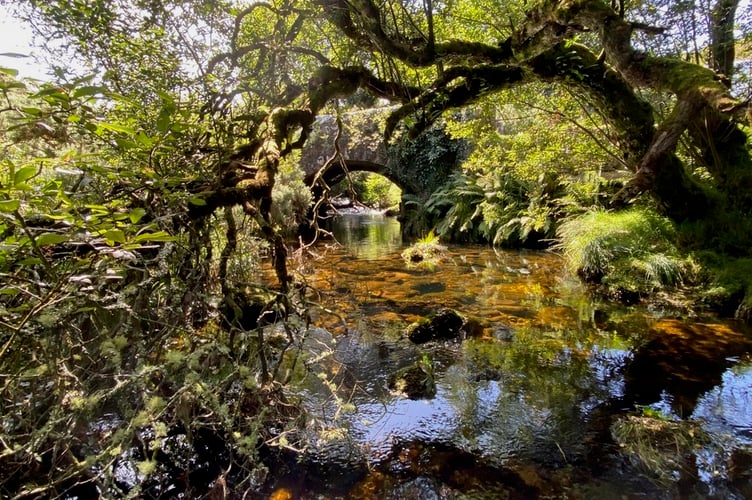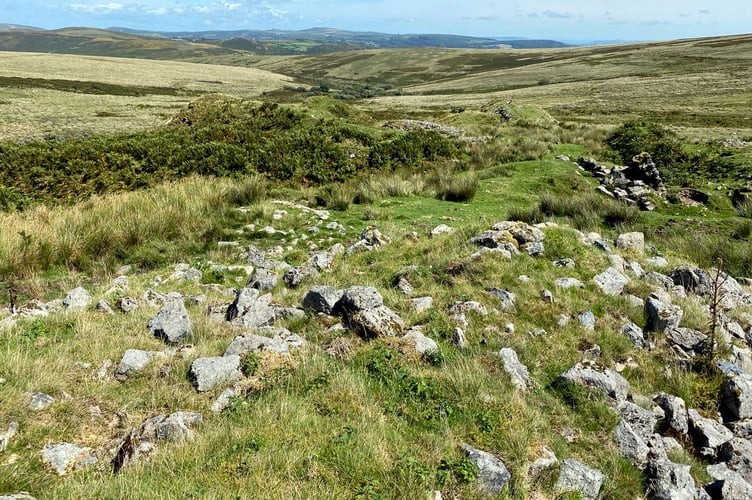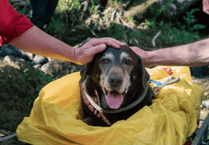IT’S hard to believe that in the middle of the summer, when thousands of visitors have made the mad dash to Devon, there are places so quiet it feels as if the county has been deserted, says Rambling Man Nigel Canham.
Yet with Dartmoor on our doorstep that’s no problem at all, take Holne Moor for example.
Barely a stone’s throw from Buckfastleigh and Ashburton, it’s possible to have as much space there as any rambling man could wish for.
A recent walk with my brother Ric, recovering from a critical illness, started at Saddle Bridge between Hexworthy and Combestone Tor.
Our modest 4.5-mile route took us along the banks of the O Brook, a beautiful moorland stream with an intriguing name.
Adrian Coulston, a former General Manager for the National Trust on Dartmoor, claims it’s an abbreviation of Oke, Ock or Oak and that the valley would once have been similar to Wistman’s Wood.

But although the area still boasts native trees, many more were felled by medieval tin miners, evidence of whom is all around in the shape of stony troughs and ridges left by streaming - washing out ore by diverting watercourses across exposed seams.
Chris Popham, writing for the Open University Geological Society, states that one of the main aims of the Roman invasion of AD43 was to gain control of our tin reserves.
The first written records of extraction on Dartmoor, he tells us, began in the 1100s but by then the industry was already a big one.
The Tinners were not only exempted from some taxes and civic duties but had established their own laws and took on anyone who dared stand in their way.
Their prison in Lydford was notoriously tough, with English Heritage, the current caretakers, recalling the words of one inmate who said it was ‘the most annoious, contagious and detestable place within this realm’.

Popham writes that in the 1200s the Crown tried to take control of the south-west industry but 11,000 miners threatened revolt and started to march on London.
The Crown backed down and soon Ashburton, Chagford, Tavistock and Plympton became stannary towns – stannum is Latin for tin – where dues were collected and assaying and second smelting were carried out.
Plympton later suffered from the industry’s success however as its usefulness as a port diminsihed when the River Plym become silted up with waste from the mines, allowing Plymouth to rise in importance.
Back to our walk and the land from Saddle Bridge rises gently, although conditions underfoot are made tricky in places by boggy ground and the rock-strewn streaming remains.
Reduced grazing in recent years has also allowed the bracken to become rampant and head high.
One fascinating element to this part of the route is the Holne Moor Leat which appears for the whole world to be flowing upstream.
This optical illusion is only replicated, as far as I know, by Electric Brae, a hill in Ayrshire where the author has drawn up in a car, applied the handbrake and released it again only to find the car rolling ‘uphill’.
On our walk again, having crossed Dry Lake where streaming had taken place since the 13th century, the spoil heaps of Hooten Wheals Mine become evident on the hillside ahead.
On arrival it’s clear that this site was worked much more recently than medieval times and indeed, Popham tells us that tin was extracted here until the early 20th century.
There are remains of buddles in which ore was washed, a wheelpit and more besides, including a shaft which once went to a depth of 300ft.
Cross to the other side of the O Brook and you’ll find remains of the captain’s house and dormitory for up to 12 miners.
Apparently, the men began their working week at 7am on Monday and finished at 2pm on Saturday, having walked as far as 11 miles and bringing food and supplies.
Popham writes: ‘Activity was cut back at the outset of the Great War due to a lack of manpower and then stopped altogether with the intention to return to full production afterwards. However, this was not a success and as one account recalls ‘the men employed were far more interested in getting to the bottom of the next bottle than ever they were of doing any mining’.’.
Production ceased in 1920 and in the 1930s the site was used as target practice during tank training exercises.
Ric and I had lunch, sitting upon the rubble of what was once an engine house, and the views were both wide and beautiful.
From this lovely spot we made our way up and over Skir Hill to see Skir Gut, a great slash in the hillside and the largest example of tin streaming known to me.
The only sounds were those of the wind and birds, the vast sun-dappled landscape being entirely our own, and what a sky, all mackerel clouds and mare’s tails set against the August blue.
As easy as our walk was meant to be however, we were given a salutary lesson in never underestimating the challenges of crossing Dartmoor.
With no obvious paths to follow and the map suggesting only benign rough grassland, scrub and occasional bog, at least half our route had to be made, step by very careful step, across ankle breaking tussocks disguised in long grass and with drops of a foot or more should a boot land in the wrong place.
The mires were extensive and had to be avoided, as did the untamed bracken which, when descending back into Dry Lake, managed to both grab our feet and hide boulders ripe for tripping on.
Make no mistake though, as unexpectedly tough as the short walk had been, we both felt enriched beyond words by the beauty, peace, history and nature of a place so close to so many people and yet inhabited only by us on the day.
Anyone with the ability to use two legs but who never ventures far from Dartmoor’s car parks and tourist spots are denying themselves a passport into a world of unimaginable delight and wonder.
Ric very nearly lost that gift through illness and like me, treasures it dearly.
There’s no time like the present, get those boots on!
For advice on outdoor safety visit www.dartmoor.gov.uk/enjoy-dartmoor/planning-your-visit/safety-advice-for-outdoor-activities


-with-lightning).jpeg?width=209&height=140&crop=209:145,smart&quality=75)


Comments
This article has no comments yet. Be the first to leave a comment.